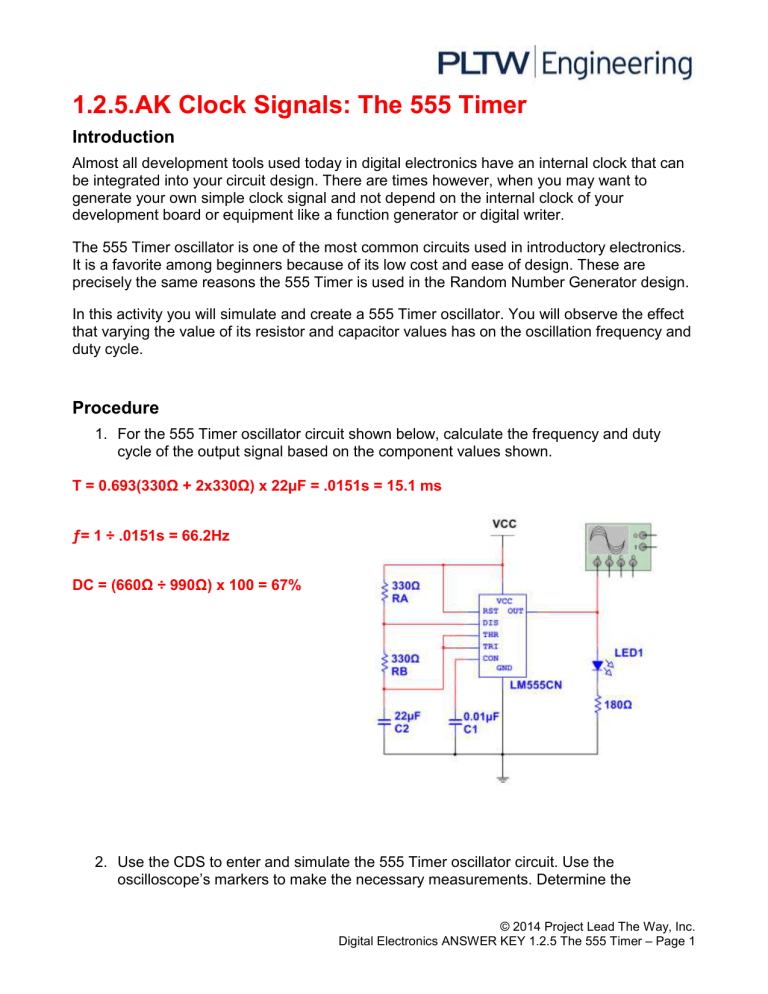555 Timer Oscillator: Answer Key - Digital Electronics
advertisement

1.2.5.AK Clock Signals: The 555 Timer Introduction Almost all development tools used today in digital electronics have an internal clock that can be integrated into your circuit design. There are times however, when you may want to generate your own simple clock signal and not depend on the internal clock of your development board or equipment like a function generator or digital writer. The 555 Timer oscillator is one of the most common circuits used in introductory electronics. It is a favorite among beginners because of its low cost and ease of design. These are precisely the same reasons the 555 Timer is used in the Random Number Generator design. In this activity you will simulate and create a 555 Timer oscillator. You will observe the effect that varying the value of its resistor and capacitor values has on the oscillation frequency and duty cycle. Procedure 1. For the 555 Timer oscillator circuit shown below, calculate the frequency and duty cycle of the output signal based on the component values shown. T = 0.693(330Ω + 2x330Ω) x 22µF = .0151s = 15.1 ms ƒ= 1 ÷ .0151s = 66.2Hz DC = (660Ω ÷ 990Ω) x 100 = 67% 2. Use the CDS to enter and simulate the 555 Timer oscillator circuit. Use the oscilloscope’s markers to make the necessary measurements. Determine the © 2014 Project Lead The Way, Inc. Digital Electronics ANSWER KEY 1.2.5 The 555 Timer – Page 1 frequency and duty cycle of the output signal. How do these values compare to the calculated values? The difference between Marker 1 and Marker 2 in the figure above shows a period of 15.1ms. ƒ = 1 ÷ 15.1ms = 1 ÷ .0151s = 66.2Hz The difference between Marker 1 and Marker 2 in the figure above shows a Time High of 10.1ms. Recall that the period was 15.1ms. DC = (tH ÷ T) x 100 = (10.1ms ÷ 15.1ms) x 100 = 67% How do these values compare to the calculated values? Should be the same. 3. Repeat steps (1) and (2) for each set of component values in the table shown below. Note that the shaded areas are the values that were measured from the original circuit. © 2014 Project Lead The Way, Inc. Digital Electronics ANSWER KEY 1.2.5 The 555 Timer – Page 2 RA RB C2 Period(T) Frequency(ƒ) tH tL Duty Cycle 100 330 22 F 11.6ms 86.2Hz 6.6ms 5ms 57% 330 330 22 F 15.1ms 66.2Hz 10.1ms 5ms 67% 560 330 22 F 18.6ms 53.8Hz 13.6ms 5ms 73% 330 100 22 F 8.1ms 123.5Hz 6.5ms 1.6ms 80% 330 330 22 F 15.1ms 66.2Hz 10.1ms 5ms 67% 330 560 22 F 22.2ms 45.1Hz 13.6ms 8.6ms 61% 330 330 10 F 6.9ms 144.9Hz 4.6ms 2.3ms 67% 330 330 22 F 15.1ms 66.2Hz 10.1ms 5ms 67% 330 330 47 F 32.3ms 31Hz 21.5ms 10.8ms 67% 4. Review the results of the data collected in step (3) of the procedure. What effect did varying the RA have on the frequency and duty cycle? As the resistor value for RA increases; frequency (ƒ) decreases and Duty Cycle (DC) increases. What effect did varying the RB have on the frequency and duty cycle? As the resistor value for RB increases, frequency (ƒ) decreases and Duty Cycle (DC) decreases. What effect did varying the C2 have on the frequency and duty cycle? As the capacitor value for C increases, frequency (ƒ) decreases and Duty Cycle (DC) remains constant. In the previous activity you created a 4-bit counter that counted from 0-15 in binary. We used a provided clock source. (Internal clock in the development board or a software generated clock source). © 2014 Project Lead The Way, Inc. Digital Electronics ANSWER KEY 1.2.5 The 555 Timer – Page 3 Using what you have learned about the relationships between RA, RB, C2 and how they impact the frequency output of the clock signal, create your own 555 Timer oscillator circuit on your development board. (Note: The simulation was helpful in determining how RA, RB, and C2 impact the 555 Timer oscillator design. However, the software simulated frequency can be affected by the processor on your computer. The frequency rate may appear slightly different in your actual design compared to your simulated design. Also, your design may be limited by the resistors and capacitors available.) Simulation 5. Using the Circuit Design Software (CDS) use the clock signal of the 555 Timer to trigger the 4-bit binary counter you created previously. Breadboard 6. Create the circuit on your breadboard. (Remember you may need to use different resistor and capacitor values to find a clock signal rate you are comfortable with. LM 555 Timer 74LS47 D Flip-flop © 2014 Project Lead The Way, Inc. Digital Electronics ANSWER KEY 1.2.5 The 555 Timer – Page 4 Digital MiniSystem (DMS) Digital Logic Board (DLB) © 2014 Project Lead The Way, Inc. Digital Electronics ANSWER KEY 1.2.5 The 555 Timer – Page 5




